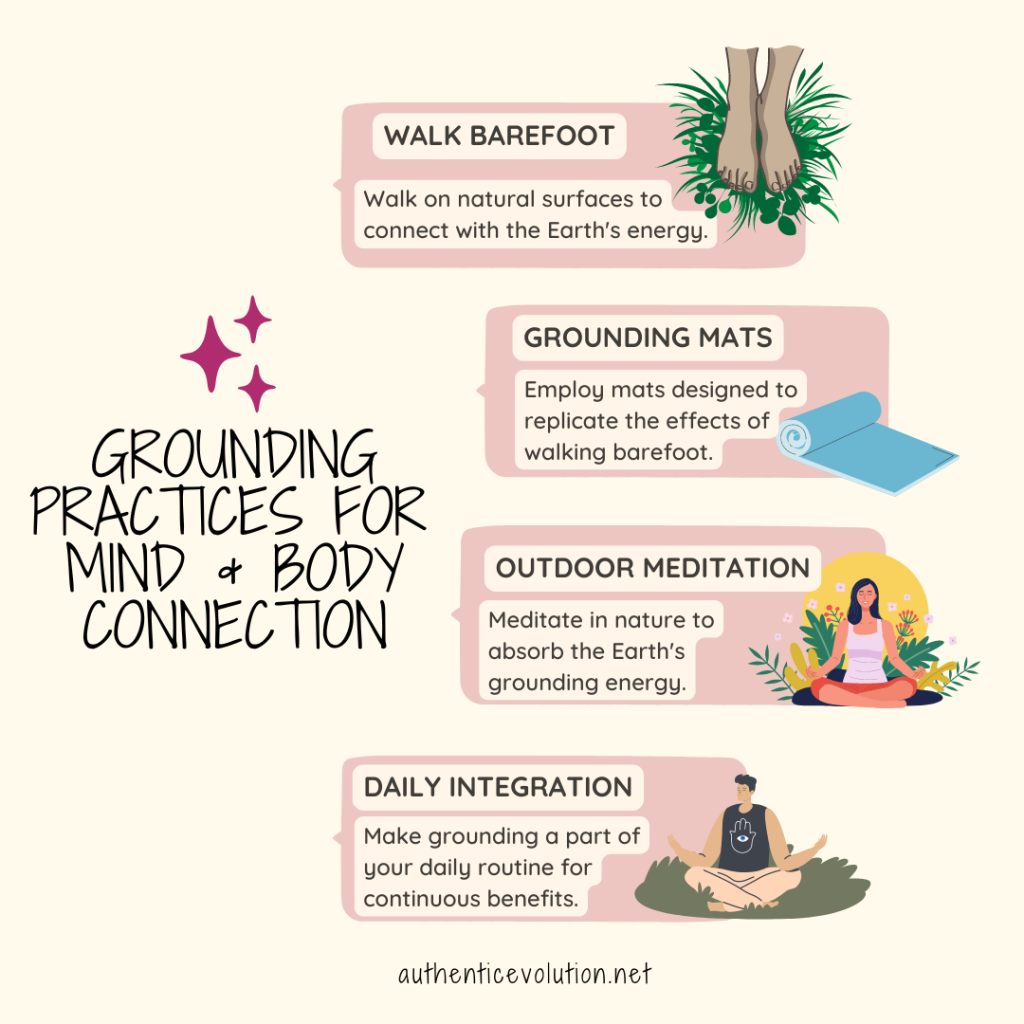
In a world increasingly disconnected from nature, grounding – the practice of connecting your body directly to the Earth – is more important than ever. As we spend more time indoors, surrounded by technology and artificial surfaces, our bodies are deprived of the Earth’s natural healing energy. This disconnection can lead to a range of physical and mental health issues, including stress, anxiety, inflammation, and sleep disturbances.
Grounding, also known as earthing, offers a simple yet powerful way to restore this vital connection. By making grounding a regular part of your daily routine, you can tap into a range of surprising health benefits that extend far beyond just feeling more connected to the Earth.

What is Grounding?
At its core, grounding involves physically connecting your body to the Earth’s surface. This can be done by walking barefoot on natural surfaces like grass, sand, or soil, or by using specialized grounding devices that bring the Earth’s natural electrical charge indoors. The practice of grounding allows your body to absorb the Earth’s electrons, which can help neutralize harmful free radicals and restore the body’s natural balance.
Grounding is not just a feel-good practice; it’s supported by science. Research has shown that grounding can reduce inflammation, improve sleep quality, lower stress levels, and even support cardiovascular health. In this article, we’ll explore the science behind grounding, the numerous health benefits it offers, and practical techniques for incorporating this ancient practice into your modern lifestyle.
The Science Behind Grounding
The Earth’s surface carries a negative electrical charge, while the human body tends to accumulate positive charges from exposure to electromagnetic fields (EMFs) and other sources of electrical pollution. This electrical imbalance can lead to oxidative stress, inflammation, and a host of other health issues.
Grounding helps to neutralize these positive charges by allowing the body to absorb the Earth’s negative electrons. This process can help reduce inflammation, lower stress, and promote overall well-being. For instance, a study published in the Journal of Alternative and Complementary Medicine found that grounding during sleep reduced nighttime cortisol levels—a stress hormone—and significantly improved sleep quality in participants.
Further research has shown that grounding can also support the autonomic nervous system by promoting a balance between the sympathetic nervous system (responsible for the “fight or flight” response) and the parasympathetic nervous system (responsible for relaxation and healing). This balance is crucial for maintaining overall health and resilience to stress.
The Health Benefits of Grounding
Grounding offers a wide range of health benefits, many of which have been supported by scientific research. Here’s a closer look at some of the key benefits:
1. Reduces Inflammation and Chronic Pain
Inflammation is the body’s natural response to injury or infection, but chronic inflammation can lead to various health issues, including arthritis, diabetes, and cardiovascular disease. Grounding has been shown to reduce inflammation by neutralizing free radicals, which are unstable molecules that can damage cells and contribute to chronic inflammation.
A study published in the Journal of Inflammation Research found that grounding reduced the levels of several inflammatory markers, including white blood cell count and C-reactive protein (CRP). Participants in the study reported significant reductions in pain and stiffness after practicing grounding for just four weeks.
For those suffering from chronic pain conditions like arthritis, grounding can be particularly beneficial. A pilot study on patients with osteoarthritis found that participants who slept on a grounded mat for eight weeks experienced decreased pain and improved physical function.
2. Improves Sleep Quality
Sleep is essential for overall health and well-being, yet many people struggle with sleep disorders or poor sleep quality. Grounding has been shown to regulate the body’s circadian rhythm—the internal process that governs the sleep-wake cycle—by synchronizing it with the Earth’s natural cycles.
One of the reasons grounding improves sleep quality is its impact on melatonin production. Melatonin is a hormone that regulates the sleep-wake cycle and is produced in response to darkness. Grounding has been shown to increase melatonin levels, helping to improve sleep quality and duration.
In a study published in the Journal of Alternative and Complementary Medicine, participants with sleep disturbances who practiced grounding reported falling asleep faster, waking up less during the night, and feeling more refreshed in the morning.
3. Boosts Mood and Reduces Stress
Chronic stress can have a profound impact on physical and mental health, contributing to conditions such as heart disease, depression, and weakened immune function. Grounding has been shown to reduce stress hormones, such as cortisol, and promote feelings of calmness and well-being.
A study published in Psychological Reports found that grounding reduced stress and improved mood in participants. They reported feeling less anxious, depressed, and fatigued after practicing grounding for just one hour. This mood-boosting effect is likely due to grounding’s ability to activate the parasympathetic nervous system, which promotes relaxation and healing.
4. Supports Cardiovascular Health
Cardiovascular disease is a leading cause of death worldwide, and many risk factors, such as high blood pressure and inflammation, can contribute to its development. Grounding has been shown to support cardiovascular health by improving blood flow and reducing blood viscosity, which can lower the risk of blood clots and improve circulation.
In addition, grounding has been shown to increase heart rate variability (HRV), an indicator of autonomic nervous system function and cardiovascular health. Higher HRV is associated with better cardiovascular health and resilience to stress.
5. Enhances Athletic Performance and Recovery
For athletes and fitness enthusiasts, grounding offers a natural way to enhance performance and speed up recovery. Grounding has been shown to reduce muscle damage and inflammation, leading to faster recovery times after intense exercise.
A study published in the Journal of Strength and Conditioning Research found that grounding improved recovery and reduced muscle damage after eccentric exercise. Participants who practiced grounding reported less pain and faster recovery compared to the control group.
Additionally, grounding can help alleviate delayed onset muscle soreness (DOMS)—the pain and stiffness felt in muscles after unaccustomed or strenuous exercise—by reducing inflammation and oxidative stress.

Practical Grounding Techniques for Everyday Life
Incorporating grounding into your daily routine is simple and can provide numerous health benefits. Here are some practical techniques to help you get started:
1. Barefoot Walking
Walking barefoot on natural surfaces like grass, sand, or soil is one of the simplest and most effective ways to ground yourself. Aim to walk barefoot for at least 30 minutes a day. Pay attention to the sensations of your feet connecting with the Earth, the texture of the surface, and the temperature of the ground. This mindful approach can enhance the grounding experience and help reduce stress.
If you’re new to barefoot walking, start slowly to allow your feet to adjust. Be mindful of your surroundings and avoid sharp objects or uneven terrain. If walking on rough surfaces, consider using minimalist footwear that allows your feet to maintain contact with the ground.
2. Using Grounding Mats and Sheets
For those who spend most of their day indoors, grounding mats and sheets offer a convenient way to stay connected to the Earth. These products are designed to mimic the effects of direct contact with the ground by using conductive materials that are connected to the Earth via a grounded outlet or a grounding rod.
Place a grounding mat under your feet while sitting at your desk or on the couch, or use a grounding sheet while sleeping. Aim to use these products for at least 30 minutes per session to experience the benefits of grounding.
3. Outdoor Meditation or Yoga
Practicing meditation or yoga outdoors, directly on the ground, is another effective way to ground yourself. Find a quiet spot in nature, such as a park or forest, and sit or stand directly on the grass or soil. Begin your practice by focusing on your breath and the sensation of your body connecting with the Earth. As you move through your session, visualize the Earth’s energy flowing up through your feet and into your body, promoting a sense of calm and balance.
Choose a location that feels safe and peaceful, away from distractions and noise. Use a natural mat, such as a grass mat or a cotton yoga mat, to maintain a connection with the ground. Practicing during the early morning or late afternoon, when the Earth’s energy is most intense, can enhance the grounding experience.
4. Grounding at Work
Even during a busy workday, you can incorporate grounding practices to stay connected with the Earth. Consider using a grounding mat at your desk or taking short breaks to walk barefoot outside. If your workplace has an outdoor area, use it for walking meetings or take your lunch break outside to connect with nature.
5. Grounding at Home
Your home should be a sanctuary where you can relax, recharge, and connect with the Earth. Create a dedicated grounding space in your home, preferably outdoors, where you can regularly practice grounding. This could be a small garden, a balcony, or a corner of your backyard with direct access to natural surfaces like grass or soil.
Enhance this space with comfortable seating, such as a bench or meditation cushions, and add natural elements like plants or a small water feature to create a calming atmosphere. You can also use grounding sheets on your bed to maintain a connection with the Earth throughout the night.
“The Earth has its own energy, and when we connect to it, we align our bodies with its natural rhythms, promoting healing and balance.”— Clinton Ober
The Importance of Grounding in Modern Life
In today’s fast-paced, technology-driven world, grounding provides a simple, accessible, and cost-effective way to support your body’s natural healing processes. Whether you choose to walk barefoot on the Earth, use grounding products, or practice outdoor meditation, making grounding a regular part of your life can have a profound impact on your health.
Make Grounding a Part of Your Daily Routine
Grounding offers a simple yet powerful way to improve your health and well-being. By connecting with the Earth’s natural electrical charge, you can reduce inflammation, improve sleep quality, and boost your mood.
Start small by incorporating a few minutes of grounding into your daily routine. Whether it’s taking a barefoot walk in your backyard or using a grounding mat at work, these small steps can lead to significant improvements in your overall well-being. Embrace the power of nature and make grounding a regular practice in your life.
Further Exploration
If you’re interested in learning more about grounding and its benefits, consider checking out these resources:
- “Earthing: The Most Important Health Discovery Ever?” by Clinton Ober, Stephen T. Sinatra, and Martin Zucker
- “The Earthing Movie: The Remarkable Science of Grounding” (documentary)
- “The Grounded Body: The New Science of Earthing and Its Vital Role in Health and Healing” by Laura Koniver, MD
These resources offer a deeper dive into the science behind grounding and provide practical tips for incorporating it into your life.
You might find this process therapeutic as you tap into and express your repressed shadow self.
So, whether you’re scribbling in a journal or dancing out your feelings, shadow work is all about exploring those hidden parts of yourself and bringing them into the light.
